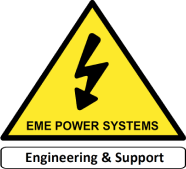PARTIAL DISCHARGE TESTING
4/5/22

As part of any substation access procedure and a major element to any periodic or predictive planned maintenance schedule to HV equipment is to test for partial discharge. Early identification of partial discharge is a very good indicator of insulating faults starting to develop and gives the opportunity to address prior to any future, possibly catastrophic, equipment failures causing unplanned downtime and unnecessary headaches.
Initial partial discharge testing is totally non intrusive and a task EME Power Systems incorporate into each of our customers maintenance schedules. Following a new client engagement only recently the importance of this was highlighted during an initial scheduled inspection at their major manufacturing facility. Partial discharge was identified at one of the customer owned ring main units which, as production was running 7 days a week, had the potential to cause unknown havoc had it gone unidentified and further developed into an equipment failure which would have shut down a significant part of the production process.
Having been identified a plan for further investigation was put into place and EME Power System’s craft staff and SAP attended out of hours to minimise any disruption to production. Stripping the unit down it was evident that humidity was the cause due to a perishing seal on one of the RMU’s cable boxes. On this occasion the PD was at a stage where it hadn’t manifested into any physical damage to the cable termination or bushings and apparent it was only ‘surface PD’ where we we’re able to clean down with no need of remaking the termination off - or worse still, having to replace a section of cable. Following replacing the seal and buttoning up we reenergised, tested again for any signs of partial discharge and were happy to say all was resolved.
“ You can never underestimate the significance of a thorough periodic preventative maintenance regime. Early detection of such things as partial discharge helps maintain safety, longevity and cost effectiveness of 11Kv assets.”
Steve Harrison, Contracting Engineer
News Stories
- Benefits of Furans Testing
- Aftermath of Storm Babet
- Emergency Response to Storm Babet’s Disruption
- Welcoming Samantha Collishaw and Reducing Carbon Footprint
- Ardagh Glass Transformer Replacement
- Considering Voltage Management to Help Cut Bills?
- Graham Haydn-Davies Retirement
- LV Sub-Main Fault
- Cable Joint Failure
- Phil Shaw Retirement
- Directional Drilling
- Pre-Planned Maintenance
- Energy Savings Factsheet
- The Benefits of Carrying Out Planned Preventative Maintenance (PPM)
- EME Transformer Stock Saves the Day!
- Storm Franklyn
- Helping to Mitigate the UK Energy Crisis
- EME Power Systems Helps Company To Join The Recycling Effort
- Christmas Time Switchgear Changes
- Out of Hours Peace of Mind
- EME Power Systems Fast Response for Major Food Manufacture
- Importance of Regular Intrusive Maintenance
- NHS Challenge
- Automated Packaging at Malvern Worcestershire
- Christmas Arrives Early
- Challenge Accepted
- Through these uncertain times...
- Hayley Paddock Joins EME Power Systems
- Challenging Times
- Low Carbon Electricity
- Our excellent installation teams complete essential works
- Fast Response
- Essential Maintenance
- Solution to a tricky transformer replacement
- It's A Cut!
- EME Power Systems Quarterly Update
- Infrastructure Upgrade
- EME Power Systems Continue As Normal
- It's Cold Inside
- Double transformer failure leads to double success
- Steve Harrison Joins the Company
- Class Cancelled
- Now For Something Slightly Different
- Go Green and Save Pounds
- Cable Fault Repair
- ACB
- Time For A Quick Change Around
- Lincoln Prison
- EME Power Systems Renewables
- An Early Summer Break - Out With The Old, In With The New
- EME Power Systems Midweek Break
